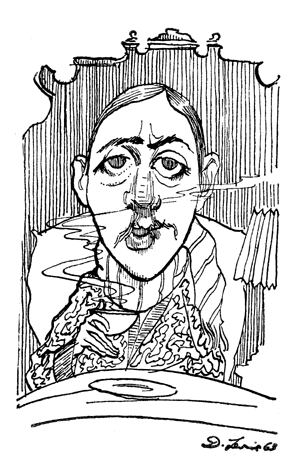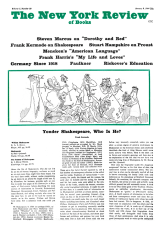Professor Shattuck shows the marks of the addict who has fought his way through his addiction to the standpoint of the interpreter, if not of the critic. I can read with pleasure almost any book about Proust, even those written by fellow addicts, which usually have the weakness of leaving the novel unrelated to the rest of literature, as if it were some kind of solitary revelation. Although he makes few comparative judgements and admits no serious shortcomings, Professor Shattuck does avoid mere wallowing enthusiasm. For he has at least one substantial point to make about the novel’s composition which is not acknowledged in Feuillerat or in Germaine Brée. Against Feuillerat he argues that the confusion of times and dates in the narrative is no blemish, due to unrevised accretions to the first draft, but rather is necessary to the final revelation in Le Temps Retrouvé, correctly interpreted: and Professor Shattuck has an interpretation of time and memory in Le Temps Retrouvé which does throw light on the arrangement of the novel.
Proust believed that we can overcome the subjectivity of our ordinary experience of persons and things, only if we can see the same persons, and the same things or places, from different standpoints in time: his was a theory of temporal perspective. As we distinguish the apparent from the objective physical properties of objects in space by varying the standpoint of the spectator, so, and more fundamentally, we can only perceive the real nature of changing things and persons, including ourselves, if, in the meeting of memories, we take a “cut” or a “fix” on them from different temporal angles. Only under this condition of re-activating the past in our mind, can we see the person or thing or place in the round, as a three-dimensional object that is independent. This is the binocular vision of the title, and there are many relevant references in Proust to X-rays, stercoscopic effects, telescopes, and other equipment.
The essential point, I think, is the use that Proust made of this doctrine of time and of timeless vision, of illusion and reality rather than the philosophical implications of the doctrine. In common with all great comic writers, Proust’s philosophical starting point was the problem of personal identity, and of the play of false identities. There must be a discoverable self, a constant individual nature, that persists through all the metamorphoses and disguises, in the Arabian Nights adventures of social life, of love and friendship. An uncertain sense of identity naturally concerned someone who, like Proust, was always a brilliant mimic and parodist, and who could lose himself in others, in passive submission to any strongly individual style. He became a writer, and he had always been a social observer, in virtue of his irrepressible gifts as a parodist; he only slowly suceeded in escaping through parody into a style of his own—through the discovery of his doctrine of Time.
Among the conclusions one might draw from Mr. Shattuck’s arrangement of evidence are these: The correspondences and analogies that cross all intervals of time, and from dream to reality, must be held together in long, accumulating sentences through long, unshaped paragraphs in a story that finally returns to its beginning. No one can discover his own true nature, and therefore the thread that gives a design to his life, unless he can hold together his past and his present, his childhood and his age, in a single fully elaborated composition, and not merely in a “happy moment” of memory. Within the composition, as in a musical theme, his past will be shown to be pregnant with his future, which was already present within his childhood, and his middle age to resume the spiraling sympathies and despairs of his childhood. The composition that is true to experience cannot have the conventional form of a continuous historical narrative, which must show the past governing the future by a transient causality—the causality of incident—and must leave no place for the slow, vegetable growths of unconscious memory. The true story must weave in and out of the temporal order, leaving dates and intervals ambiguous, in order that the recurrences and intermittences should be thrown into relief. So the narrator’s own life has its dreamlike intervals, its intervals of sleep and of forgetting; and, like Haroun-al-Raschid, he alights among the characters of the novel at uncertain intervals. There will then seem to be no unambiguous history, but rather an uneven spiralling motion in his life like the spin of some kind of top. Professor Shattuck mentions the casual, confusing references to Marcel’s years in the sanatorium. They have a purpose. Because the interval between episodes is uncertain, the development of the characters is confused, and the cross sections, taken at different times, open up, like X-rays, the contradictory natures of Swann, Charlus, Saint Loup, Odette, Mme. Verdurin, as of Marcel himself as an artist: they show that the summaries of surface qualities—“he is a snob,” “he is a homosexual,” “he is a lover of women,” “he is artistic,” etc.—are no more true than their denials. In the returning carnival and Masque of Time, these characters will all change into their opposites: bisexual, emotionally cunning in childhood and childish in old age, the normal condition of men is one of perversity, and their normal clothing is a form of transvestism. The law of opposite disguises is resumed in the All Soul’s Night of the Guermantes’ final reception at which Marcel is called to leave society and his social nature behind, and to assume his true spiritual identity as a re-creator of experience, after leaving the world of shadows. Professor Shattuck acutely analyzes the unexpected postponements which build up the tension of this stage in the novel, and the significance of the slow, moving recognition of Mme. Saint Loup.
Advertisement
I have no doubt that this book does contribute to the understanding and enjoyment of Proust. Certainly there are some exaggerated claims, and some very unfortunate comparisons with modern physics. The legitimate comparison is that between Proust’s experiments with temporal perspective, and the Cubists’ rejection of previous conventions of representing space. For both of these changes in methods of representation signalled a more ambitious idea of the relation of art to reality: that art does not follow the experience of reality, but rather reforms it.
One particular triumph of Professor Shattuck’s argument is his explication of the magical text: “Longtemps, je me suis couché de bonne heure.” It is an evident pleasure for him to extract, as I think he legitimately tries to do, a premonition of the principal theme from the subtle choice of tense in this first sentence: for at this point he is following Proust’s own famous comment on Haubert’s use of the past tense.
This is not a work of literary criticism. And finally, the old critical questions are provoked by its enthusiasm. Is the Proustian picture of experience, as in all essential respects solitary, a plausible or even a possible picture? Does the narrator’s pursuit of the real self, through the trials of love and friendship and society, really falsify the experience of love, of friendship and of society? Is the sentimental education of Marcel too circular, too static, since the end is implied in the beginning? The lantern of his consciousness is moved round and finds its phantasmagoric effects: but can it be true, as it is necessary for Proust to claim, that all honest views of experience are an approximation to artistic creation, which is the most solitary of acts, and to the exploration of an individual style? Can this aesthetic solipsism be more than a splendid device of comedy, which allows recognition scenes, transformation, the reversal of values, the fading of illusions into reality and of reality into illusions? As in all perfect comedy, the substance of the intrigue sometimes seems to have disappeared into the luxury of the hero’s observation of it. Marcel seems to wake up from a long sleep and from a dream, the dream of purposive action, when at the end he takes up his pen and writes that first sentence—“Longtemps, je me suis couché de bonne heure.” There is a kind of Quixotism in this substitution of the representation for the fact, of a book for a life. But Professor Shattuck has once again shown the heroic consistency of the plan, even at points where the writing may seem casual and hurried.
This Issue
January 9, 1964




